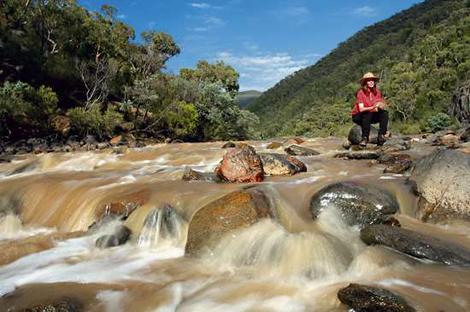www.smh.com.au
Home » Specials » Environment » Article
2800km coastal route for wildlife to escape warming

Letting the wildlife flow...
Lauren Van Dyke, property manager of Scottsdale, on the Murrumbidgee
River.
Scottsdale will form a vital link in the corridor.
Photo: Andrew Taylor
February 24, 2007
A 2800-KILOMETRE wildlife corridor will be established along almost the entire east coast of Australia, allowing plants and animals to move as climate changes.
State and federal governments, led by NSW, have agreed that the plan is one of the nation's highest environmental priorities for this year.
The outgoing state Environment Minister, Bob Debus, will announce first-stage funding of $7 million worth of incentives to private landowners.
The money will be spent restoring and maintaining land along the Great Eastern Ranges corridor. The Government promises there will be no compulsory acquisitions.
Instead, private landholders will be encouraged to undertake land care works and sign voluntary conservation agreements. Planning instruments would also be reformed to ensure that connections between ecosystems are maintained and restored when development decisions are made.
"We have to create, protect and restore ecological corridors that will allow species to move, and to find new areas of sanctuary," Mr Debus told the Herald.
Currently, much of the state's reserve system has become isolated - islands of conservation from which species cannot move as the world warms. Nearly two-thirds of the state's threatened species are found along the land the corridor would encompass.
Presently, however, many of these species will be stranded as the climate changes.
Last year the Bureau of Meteorology estimated that the current rate of global warming was the equivalent of a town moving northwards 100 kilometres each year.
The corridor would also improve the management of the nation's most economically significant watersheds, including the Murray and the Darling.
"To do what we can in this country to help avoid the threat of mass global warming-induced extinction, I believe we must look to better protect the ecological integrity of this 2800-kilometre corridor," Mr Debus said.
The Australian Bush Heritage Fund will announce the acquisition of the first property specifically identified as part of the corridor. Scottsdale is 1300 hectares south of Canberra at Bredbo, taking in critical platypus and native fish habitat in the Murrumbidgee River, vast native grasslands, dry sclerophyll forest and numerous endangered species. It will be crucial in helping to close a gap not only in the Great Eastern Ranges corridor but also another proposed connection between Kosciuszco and the coast.
The Australian Bush Heritage Fund is a non-profit organisation that buys high-conservation land with donations from the public and government. It has formed partnerships with the NSW Department of Environment and Conservation, other agencies and community groups to establish wildlife corridors.
The co-ordinator of the project with the Bush Heritage Fund, Stuart Cowell, said it was not possible to rely only on reserves to guarantee the long-term survival of species. "We need to work with other landholders," he said. "It's becoming more essential that we give species and ecological communities room to move."
The governments' proposed initiative will stretch from the Victorian Alps through to Atherton in Queensland and will include existing national parks, state forests and other Crown land. Currently, however, the corridor is broken by hundreds if not thousands of private properties. The hardest links to restore are expected to be in the Upper Hunter and parts of Queensland, where large tracts of land have been cleared for agriculture. Once complete, the Alps to Atherton wildlife corridor will be among the longest in the world.
Ian Pulsford, who wrote a discussion paper on the corridor and is the NSW Government's manager for conservation on private land program, said the corridor would be like a terrestrial version of the Great Barrier Reef - only longer. "It's about raising awareness of this great continental scale ribbon of land."